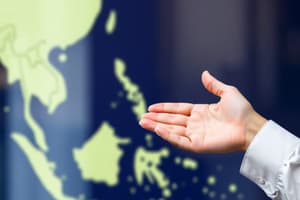Podcast
Questions and Answers
What does ASEAN stand for and when was it established?
What does ASEAN stand for and when was it established?
Association of Southeast Asian Nations; 1967
Which countries are members of ASEAN?
Which countries are members of ASEAN?
Brunei, Cambodia, Indonesia, Laos, Malaysia, Myanmar, the Philippines, Singapore, Thailand, and Vietnam
What was the objective behind the formation of the ASEAN Economic Community (AEC)?
What was the objective behind the formation of the ASEAN Economic Community (AEC)?
To create a single market and production base in Southeast Asia
When was SAARC founded and how many member nations does it have?
When was SAARC founded and how many member nations does it have?
Name three member nations of SAARC.
Name three member nations of SAARC.
What is the primary objective of SAARC?
What is the primary objective of SAARC?
What are some of the issues that SAARC has addressed?
What are some of the issues that SAARC has addressed?
What has hindered the progress of SAARC?
What has hindered the progress of SAARC?
What are the key components of ASEM's success?
What are the key components of ASEM's success?
What are some challenges faced by Asian regionalism?
What are some challenges faced by Asian regionalism?
What are some opportunities for Asian regionalism?
What are some opportunities for Asian regionalism?
What recent events have highlighted the importance of regional cooperation?
What recent events have highlighted the importance of regional cooperation?
Flashcards are hidden until you start studying
Study Notes
Asian Regionalism: ASEAN, SAARC, and ASEM
Asian regionalism refers to the process of strengthening economic, political, and social ties between Asian countries to foster cooperation, trade, and peace. This article will explore three key organizations involved in this endeavor: the Association of Southeast Asian Nations (ASEAN), the South Asian Association for Regional Cooperation (SAARC), and the Asia-Europe Meeting (ASEM).
The Association of Southeast Asian Nations (ASEAN)
Established in 1967, ASEAN initially aimed to promote peace, economic growth, and social progress in Southeast Asia. The member countries—Brunei, Cambodia, Indonesia, Laos, Malaysia, Myanmar, the Philippines, Singapore, Thailand, and Vietnam—share a combined population of over 650 million people. ASEAN's success can be attributed to its expansion, increased trade, and the formation of the ASEAN Economic Community (AEC) in 2015, which aimed to create a single market and production base in Southeast Asia.
The South Asian Association for Regional Cooperation (SAARC)
Founded in 1985, SAARC comprises eight member nations: Bangladesh, Bhutan, India, Maldives, Nepal, Pakistan, Sri Lanka, and Afghanistan. SAARC's primary objectives are to promote economic and social progress, cultural development, and collective self-reliance in the region. SAARC has been instrumental in addressing poverty, health, and disaster management issues, but its progress has been hindered by occasional political disputes and geopolitical challenges between its members.
The Asia-Europe Meeting (ASEM)
Launched in 1996, ASEM fosters dialogue and cooperation between Asia and Europe, bringing together 53 partners—30 European Union member states and their institutions, and 21 other Asian countries—to discuss politics, economy, and culture. ASEM's success can be attributed to its emphasis on inclusivity, multilateralism, and the promotion of mutual understanding and respect between the two regions. ASEM has been instrumental in facilitating trade and investment, as well as addressing global challenges such as climate change, migration, and security.
Challenges and Opportunities
Despite the significant progress made by these organizations, Asian regionalism faces several challenges. These include ongoing political tensions, economic disparities, and environmental concerns. The ongoing US-China trade conflict and the territorial disputes in the South China Sea have called into question the region's ability to maintain peace and stability. Furthermore, economic disparities between developed and developing Asian nations have hindered the region's ability to achieve inclusive economic growth.
However, there are also significant opportunities for Asian regionalism. The rapid growth of Asian economies and the increasing importance of the region on the global stage have created opportunities to strengthen cooperation and collaboration. The pandemic has highlighted the importance of regional cooperation in addressing public health crises, and it has also created opportunities for the region to work together in building economic resilience.
In conclusion, Asian regionalism is a complex and dynamic process that encompasses a variety of organizations and initiatives aimed at strengthening economic, political, and social ties between Asian nations. While Asian regionalism faces several challenges, there are also significant opportunities for cooperation and collaboration in addressing the region's most pressing issues. By working together, Asian nations can build a more prosperous, inclusive, and peaceful region.
Studying That Suits You
Use AI to generate personalized quizzes and flashcards to suit your learning preferences.




